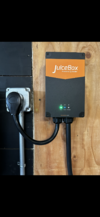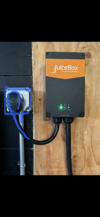Six years ago an electrician installed a couple new circuits on our breaker box. One was a 40A 240v specifically for charging a car. The other was a 20A 120v circuit as a backup charging circuit. The 240 ends in a 14-50 outlet in which a JuiceBox40, of similar age, has been used. When my wife charges her car, it is limited to 12A 240v, and the breakers get warm to the touch after 15 minutes. When I charge my Y at 31A 240v, the breakers in the panel get beyond warm -- I might say they get hot. We have a suspicion that the breaker has tripped at least once while charging the Y, as charging output slowed down to a crawl. It hasn't since, but the breakers are always warm/hot when in use.
We have tried charging with the Tesla Mobile connector as well, at 32A 240v, and breakers also get pretty hot. So I can rule out both cars and probably both EVSE's as a cause.
The breaker box is a decades-old GE 100A, and the breakers are 6 year-old GE brand. I think I remember that the electrician said he had to match brands so they would fit in the breaker box. The run to the 14-50 outlet is about 12 to 15 feet. I don't know if the wiring is 6 or 8 gauge.
So, what should we be looking to do? Do your breakers get warm or hot when at 80% load? Have you ever checked them well into a charging cycle? I can guess it might be a connection of the breakers into the panel bus? Could be crappy breakers? Or a wire loosening on the breaker? Or maybe the wiring is sub-par for a 40A 14-50 useage? What should we be asking an electrician to check, or maybe replace?
In the mean time, we've been charging the Prius Prime at its full charging spec which is 12A 240. I have limited my Tesla charging down to 20A and they get less hot, but the situation is still troubling me. We have also used the 20A 120v circuit as our other portable EVSE's are limited to 12A 120v and that in no way makes the breaker warm. Even with another 120v circuit which is a 15A (standard), that breaker is cool to the touch when charging to 80% of that circuit capacity.
Breakers:

Charging area outside, under the covered porch:

We have tried charging with the Tesla Mobile connector as well, at 32A 240v, and breakers also get pretty hot. So I can rule out both cars and probably both EVSE's as a cause.
The breaker box is a decades-old GE 100A, and the breakers are 6 year-old GE brand. I think I remember that the electrician said he had to match brands so they would fit in the breaker box. The run to the 14-50 outlet is about 12 to 15 feet. I don't know if the wiring is 6 or 8 gauge.
So, what should we be looking to do? Do your breakers get warm or hot when at 80% load? Have you ever checked them well into a charging cycle? I can guess it might be a connection of the breakers into the panel bus? Could be crappy breakers? Or a wire loosening on the breaker? Or maybe the wiring is sub-par for a 40A 14-50 useage? What should we be asking an electrician to check, or maybe replace?
In the mean time, we've been charging the Prius Prime at its full charging spec which is 12A 240. I have limited my Tesla charging down to 20A and they get less hot, but the situation is still troubling me. We have also used the 20A 120v circuit as our other portable EVSE's are limited to 12A 120v and that in no way makes the breaker warm. Even with another 120v circuit which is a 15A (standard), that breaker is cool to the touch when charging to 80% of that circuit capacity.
Breakers:

Charging area outside, under the covered porch:

Last edited:




